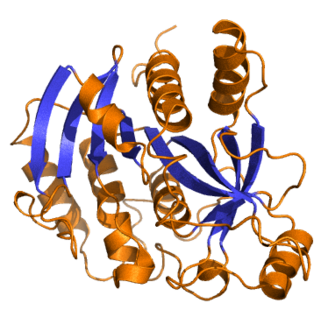
Glycogen phosphorylase is one of the phosphorylase enzymes. Glycogen phosphorylase catalyzes the rate-limiting step in glycogenolysis in animals by releasing glucose-1-phosphate from the terminal alpha-1,4-glycosidic bond. Glycogen phosphorylase is also studied as a model protein regulated by both reversible phosphorylation and allosteric effects.

Purine nucleoside phosphorylase, PNP, PNPase or inosine phosphorylase is an enzyme that in humans is encoded by the NP gene. It catalyzes the chemical reaction

Myophosphorylase or glycogen phosphorylase, muscle associated (PYGM) is the muscle isoform of the enzyme glycogen phosphorylase and is encoded by the PYGM gene. This enzyme helps break down glycogen into glucose-1-phosphate, so it can be used within the muscle cell. Mutations in this gene are associated with McArdle disease, a glycogen storage disease of muscle.

Sucrose phosphorylase is an important enzyme in the metabolism of sucrose and regulation of other metabolic intermediates. Sucrose phosphorylase is in the class of hexosyltransferases. More specifically it has been placed in the retaining glycoside hydrolases family although it catalyzes a transglycosidation rather than hydrolysis. Sucrose phosphorylase catalyzes the conversion of sucrose to D-fructose and α-D-glucose-1-phosphate. It has been shown in multiple experiments that the enzyme catalyzes this conversion by a double displacement mechanism.
In enzymology, a 1,3-beta-oligoglucan phosphorylase is an enzyme that catalyzes the chemical reaction
In enzymology, an alpha,alpha-trehalose-phosphate synthase (GDP-forming) is an enzyme that catalyzes the chemical reaction
In enzymology, an alpha,alpha-trehalose phosphorylase is an enzyme that catalyzes the chemical reaction
In enzymology, an alpha,alpha-trehalose phosphorylase (configuration-retaining) is an enzyme that catalyzes the chemical reaction
In enzymology, a guanosine phosphorylase is an enzyme that catalyzes the chemical reaction
In enzymology, a kojibiose phosphorylase is an enzyme that catalyzes the chemical reaction
In enzymology, a laminaribiose phosphorylase is an enzyme that catalyzes the chemical reaction

Thymidine phosphorylase is an enzyme that is encoded by the TYMP gene and catalyzes the reaction:
In enzymology, a trehalose 6-phosphate phosphorylase is an enzyme that catalyzes the chemical reaction
In enzymology, an urate-ribonucleotide phosphorylase is an enzyme that catalyzes the chemical reaction
In enzymology, an aldose-1-phosphate adenylyltransferase is an enzyme that catalyzes the chemical reaction
In enzymology, an aldose-1-phosphate nucleotidyltransferase is an enzyme that catalyzes the chemical reaction
Beta-D-galactosyl-(1->4)-L-rhamnose phosphorylase is an enzyme with systematic name beta-D-galactosyl-(1->4)-L-rhamnose:phosphate 1-alpha-D-galactosyltransferase. This enzyme catalyses the following chemical reaction
N,N'-diacetylchitobiose phosphorylase is an enzyme with the systematic name N,N'-diacetylchitobiose:phosphate N-acetyl-D-glucosaminyltransferase. This enzyme was found in the genus Vibrio initially but has now been found to be taken up by Escherichia coli as well as many other bacteria. One study shows that Escherichia coli can replicate on a medium that is just composed of GlcNAc a product of phosphorylation of N,N'-diacetylchitobiose as the sole source of carbon. Because E. coli can go on this medium, the enzyme is present. The enzyme has also been found in multiple eukaryotic cells as well, especially in eukaryotes that make chitin and break chitin down. It is believed that N,N'-diacetylchitobiose phosphorylase is an integral part of the phosphoenolpyruvate:glucose phosphotransferase system (PTS). It is assumed that it is involved with Enzyme Complex II of the PTS and is involved with the synthesis of chitin. The enzyme is specific for N,N'-diacetylchitobiose.
GDP-D-glucose phosphorylase is an enzyme with systematic name GDP:alpha-D-glucose 1-phosphate guanylyltransferase. This enzyme catalyses the following chemical reaction
Glycogen phosphorylase, liver form (PYGL), also known as human liver glycogen phosphorylase (HLGP), is an enzyme that in humans is encoded by the PYGL gene on chromosome 14. This gene encodes a homodimeric protein that catalyses the cleavage of alpha-1,4-glucosidic bonds to release glucose-1-phosphate from liver glycogen stores. This protein switches from inactive phosphorylase B to active phosphorylase A by phosphorylation of serine residue 14. Activity of this enzyme is further regulated by multiple allosteric effectors and hormonal controls. Humans have three glycogen phosphorylase genes that encode distinct isozymes that are primarily expressed in liver, brain and muscle, respectively. The liver isozyme serves the glycemic demands of the body in general while the brain and muscle isozymes supply just those tissues. In glycogen storage disease type VI, also known as Hers disease, mutations in liver glycogen phosphorylase inhibit the conversion of glycogen to glucose and results in moderate hypoglycemia, mild ketosis, growth retardation and hepatomegaly. Alternative splicing results in multiple transcript variants encoding different isoforms [provided by RefSeq, Feb 2011].






